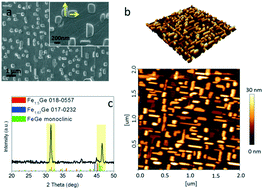Endotaxial growth of FexGe single-crystals on Ge(001) substrates†
Abstract
Revealing the “structure–property” relationship is nontrivial for the application of materials. The magnetic configurations of FeGe are strongly dependent on the internal structures and positions of Fe and Ge atoms, e.g., B20-type cubic phase configuring into magnetic skyrmions. Although endotaxial FexGe islands on (001)Ge substrate can be obtained with a dynamically controlled growth process, it is not possible to obtain the crystal structural information from conventional approaches, such as X-ray diffraction or 2D electron diffractions due to the embedded growth structures at the nanometer scale, which are too small to be probed. Through a 3D rotational electron diffraction method combined with high resolution transmission electron microscopy, we have successfully determined the specific phase of each FexGe island on the Ge substrate. Three major phases (two hexagonal and one monoclinic) were found existing in the FexGe islands with nearly equal probability and independent of the deposition temperatures and time. All the islands with different phases were inclined to {111}Ge planes, which was due to a comparatively higher energy barrier for Fe atom diffusion through {111}Ge than other Ge planes. The epitaxial growth relationship at the interface was as follows: FeGemono(4−2−1)//Ge(111), FeGemono[15−6]//Ge[1−10], Fe3Ge2(201)//Ge(111) and Fe3Ge2[−112]//Ge[1−10], Fe13Ge8(40−1)//Ge(111) and Fe13Ge8[124]//Ge[1−10]. Ferromagnetism for the as-deposited samples was observed via SQUID, which most probably is attributed to the hexagonal FeGe phases.



 Please wait while we load your content...
Please wait while we load your content...